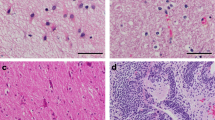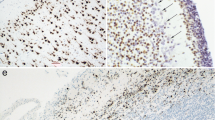Summary
Ten human teratomas arising outside the central nervous system (CNS) were studied using a panel of immunohistochemical, and lectin histochemical stains to determine the relationship of the presence of microglia to markers of neural maturity or differentiation. Microglia, identified by silver carbonate,Ricinus communis agglutinin-1 (RCA-1), or both were found in eight out of ten cases. They were common in mature areas which also had S-100, glial fibrillary acidic protein, vimentin, neurofilament, and synaptophysin immunostaining. Microglia were distinguished from macrophages in necrotic foci. Cells which were RCA-1 positive and silver carbonate positive were found in immature neural tissues but these lacked all typical features of microglia. These observations indicate that true microglia are frequent in nonCNS teratomas and that they are found in association with other indicators of neural maturation. The presence of possible precursors in immature areas suggests that microglia undergo maturation concurrent with neural differentiation in these tumors.
Similar content being viewed by others
References
Baldwin F (1980) Microglia and brain macrophages. In: Carr I, Daems WT (eds) The reticuloendothelial system —a comprehensive treatise, vol 1. Plenum Press, New York, pp 635–669
Bignami A, Raju T, Dahl D (1982) Localization of vimentin, the nonspecific intermediate filament protein, in embryonal glia and in early differntiating neurons: in vivo and in vitro immunofluorescence study of the rat embryo with vimentin and neurofilament antisera. Dev Biol 91:286–295
DeArmond SJ, Eng LF, Rubinstein LJ (1980) The application of glial fibrillary acidic (GFA) protein immunohistochemistry in neurooncology. Pathol Res Pract 168:376–394
Ferrer I, Galofré E, Soler T (1986) Structure of an isolated cerebellum and related nuclei developed within the matrix of a mature ovarian teratoma. Child's Nerv Syst 2:266–269
Giulian D, Baker TJ, Shih L-C N, Lachman LB (1986) Interleukin 1 of the central nervous system is produced by ameboid microglia. J Exp Med 164:594–604
Gould VE, Lee I, Wiedenmann B, Moll R, Chejfec G, Franke WW (1986) Synaptophysin: a novel marker for neurons, certain neuroendocrine cells, and their neoplasms. Hum Pathol 17:979–983
Haugen OA, Taylor CR (1984) Immunohistochemical studies of ovarian and testicular teratomas with antiserum to glial fibrillary acidic protein. Acta Path Microbiol Immunol Scand [A] 92:9–14
Hayes GM, Woodroofe MN, Cuzner ML (1987) Microglia are the major cell type expressing MHC class II in human white matter. J Neurol Sci 80:25–37
Herman MM, Sipe JC, Rubinstein LJ, VandenBerg SR, Spence AM, Vraa-Jensen J (1975) An experimental mouse testicular teratoma as a model for neuroepithelial neoplasia and differentiation. II. Electron microscopy. Am J Pathol 81:421–444
Hickey WF, Kimura H (1988) Perivascular microglial cells of the CNS are bone marrow-derived and present antigen in vivo. Science 239:290–292
Kahn HJ, Marks A, Thom H, Baumal R (1983) Role of antibody to S-100 protein in diagnostic pathology. Am J Clin Pathol 79:341–347
Kimura T, Budka H, Soler-Federsppiel (1986) An immunocytochemical comparison of the glia-associated proteins glial fibrillary acidic protein (GFAP) and S-100 protein (S100P) in human brain tumors. Clin Neuropathol 5:21–27
Kurtin PJ, Pinkus GS (1985) Leukocyte common antigen —a diagnostic discriminant between hematopoietic and nonhematopoietic neoplasms in paraffin sections using monoclonal antibodies: correlation with immunologic studies and ultrastructural localization. Hum Pathol 16:353–365
Kyritsis AP, Tsokos M, Triche TJ, Chader GJ (1984) Retinoblastoma — origin from a primitive neuroectodermal cell? Nature 307:471–473
Mannoji H, Yeger H, Becker LE (1986) A specific histochemical marker (lectinRicinus communis agglutinin 1) for normal human microglia, and application to routine histopathology. Acta Neuropathol (Berl) 71:341–343
Miettinen M, Rapola J (1987) Synaptophysin — an immuno-histochemical marker for childhood neuroblastoma. Acta Path Microbiol Immunol Scand [A] 95:167–170
Miller DC, Koslow M, Budzilovich G (1988) Synaptophysin as a marker in CNS neoplasms. Lab Invest 58:64A [abstr]
Nag S (1985) Ultrastructural localization of lectin receptors on cerebral endothelium. Acta Neuropathol (Berl) 66:105–110
Nakajima T, Watanabe S, Sato Y, Kameya T, Hirota T, Shimosato Y (1982) An immunoperoxidase study of S-100 protein distribution in normal and neoplastic tissues. Am J Surg Pathol 6:715–727
Nakamura Y, Becker LE, Marks A (1983) Distribution of immunoreactive S-100 protein in pediatric brain tumors. J Neuropathol Exp Neurol 42:136–145
Nogales FF Jr, Aguilar D (1983) Neural tissue in human teratomas. In: Damjanov I, Knowles BB, Solter D (eds) The human teratoma. Experimental and clinical biology. Humana Press, Clifton, pp 173–190
Norris HJ, Zirkin HJ, Benson WL (1976) Immature (malignant) teratoma of the ovary: a clinical and pathologic study of 58 cases. Cancer 37:2359–2372
Osburn M, Weber K (1983) Biology of disease: tumor diagnosis by intermediate filament typing: a novel tool for surgical pathology. Lab Invest 48:372–394
Pappas C (1981) CNS myelin and synapses in a spontaneous mouse ovarian teratoma showing neural differentiation: an immunohistochemical and electron microscopic study. J Neuropathol Exp Neurol 40:289–297
Pesce C, Tobia F, Scott T (1985) Microglia in teratomas. Acta Neuropathol (Berl) 67:332–336
Pinkus GS, Etheridge CL, O'Connor EM (1986) Are keratin proteins a better tumor marker than epithelial membrane antigen? A comparative immunohistochemical study of various paraffin-embedded neoplasms using monoclonal and polyclonal antibodies. Am J Clin Pathol 85:269–277
Schelper RL, Adrian EK Jr (1986) Monocytes become macrophages; they do not become microglia: a light and electron microscopic autoradiographic study using 125-iododeoxyuridine. J Neuropathol Exp Neurol 45:1–19
Schiffer D, Giordana MT, Mauro A, Migheli A, Germano I, Giaccone G (1986) Immunohistochemical demonstration of vimentin in human cerebral tumors. Acta Neuropathol (Berl) 70:209–219
Scott T (1971) A rapid silver impregnation technique for oligodendrocytes, microglia, and astrocytes. J Clin Pathol 24:578–580
Scott T, Pesce C (1987) The ultrastructure of the nervous tissue in a benign teratoma. Acta Neuropathol (Berl) 73:281–286
Sobel RA, Blanchette BW, Bhan AK, Colvin RB (1984) The immunopathology of acute experimental allergic encephalomyelitis. I. Quantitative analysis of inflammatory cells in situ. J Immunol 132:2393–2401
Sternberger LA, Sternberger NH (1983) Monoclonal antibodies distinguish phosphorylated and nonphosphorylated forms of neurofilaments in situ. Proc Natl Acad Sci USA 80:6126–6130
Sternberger NH, Itoyama Y, Kies MW, Webster HdeF (1978) Myelin basic protein demonstrated immunocytochemically in oligodendroglia prior to myelin sheath formation. Proc Natl Acad Sci USA 75:2521–2524
Trojanowski JQ (1987) Neurofilament protein and human nervous system tumors. J Histochem Cytochem 35:999–1003
Trojanowski JQ, Hickey WF (1984) Human teratomas express differentiated neural antigen. An immunohistochemical study with anti-neurofilament, anti-glial filament, and anti-myelin basic protein monoclonal antibodies. Am J Pathol 115:383–389
VandenBerg SR, Herman MM, Ludwin SK, Bignami A (1975) An experimental mouse testicular teratomas a model for neuroepithelial differentiation. I. Light microscopic and tissue and organ culture observations. Am J Pathol 79:147–168
VandenBerg SR, Hess JR, Herman MM, DeArmond SJ, Halks-Miller M, Rubinstein LJ (1981) Neural differentiation in the OTT-6050 mouse teratoma: production of a tumor fraction showing melanogenesis in neuroepithelial cells after centrifugal elutriation. Virchows Arch [A] 392:295–308
Wick MR, Stanley SJ, Swanson PE (1987) Immunohistochemical diagnosis of sinonasal melanoma, carcinoma, and neuroblastoma with monoclonal antibodies HMB-45 and anti-synaptophysin. Arch Pathol Lab Med 112:616–620
Wiedenmann B, Franke WW (1985) Identification and localization of synaptophysin, an integral membrane glycoprotein ofM r 38,000 characteristic of presynaptic vesicles. Cell 41:1017–1028
Author information
Authors and Affiliations
Additional information
Supported by National Institutes of Health NS 00858, and NS 26773 and National Multiple Sclerosis Society RG 1792
Rights and permissions
About this article
Cite this article
Sangruchi, T., Sobel, R.A. Microglial and neural differentiation in human teratomas. Acta Neuropathol 78, 258–263 (1989). https://doi.org/10.1007/BF00687755
Received:
Revised:
Accepted:
Issue Date:
DOI: https://doi.org/10.1007/BF00687755




